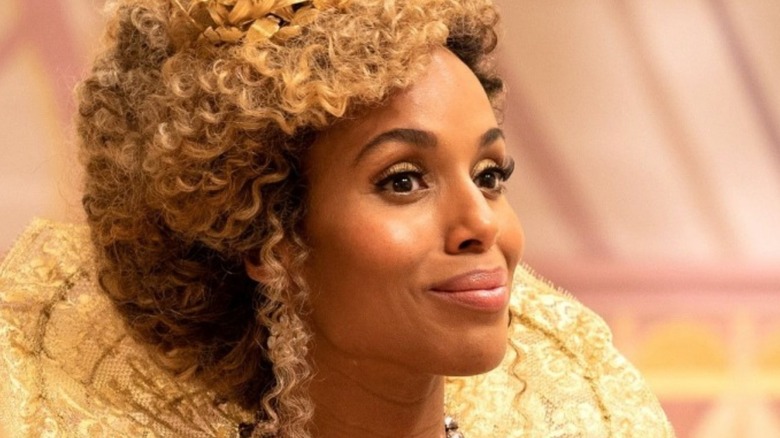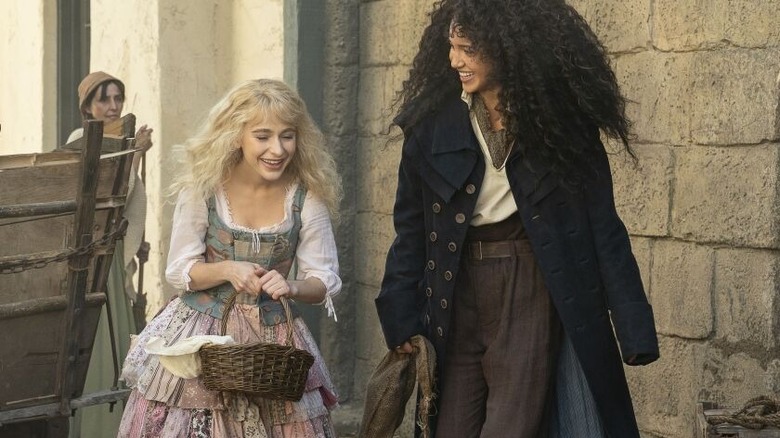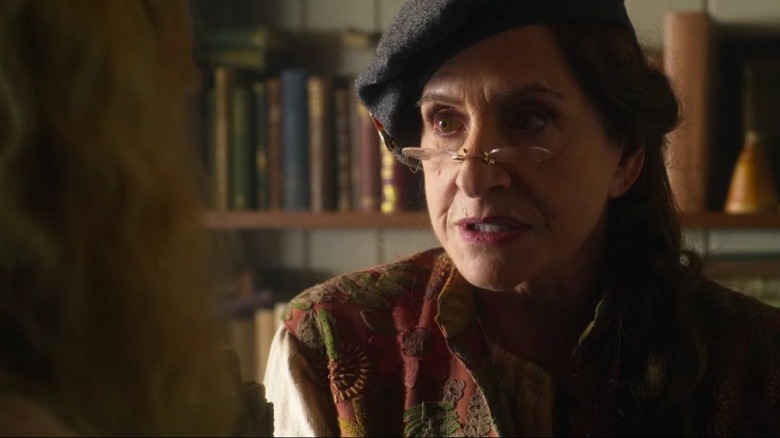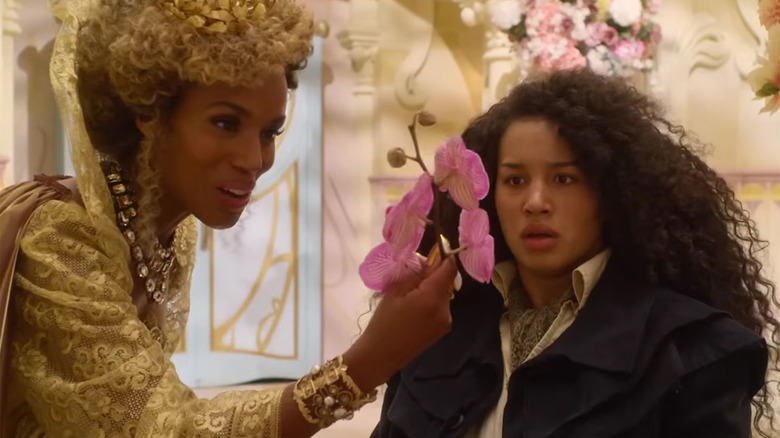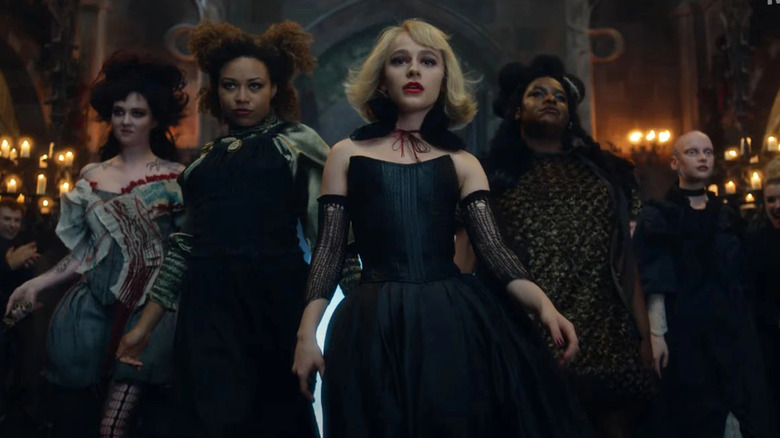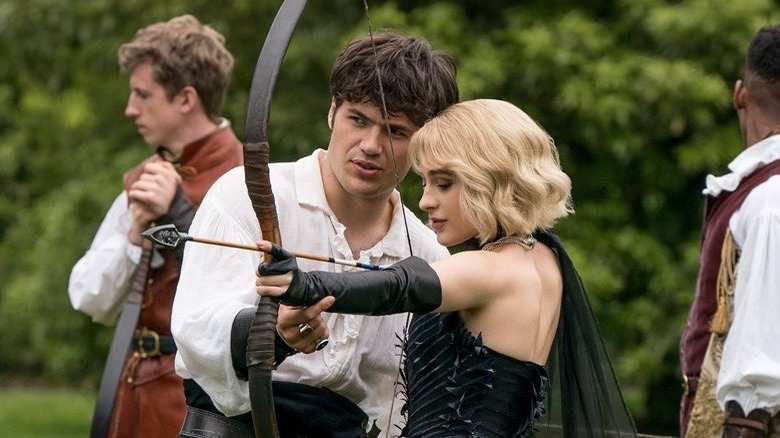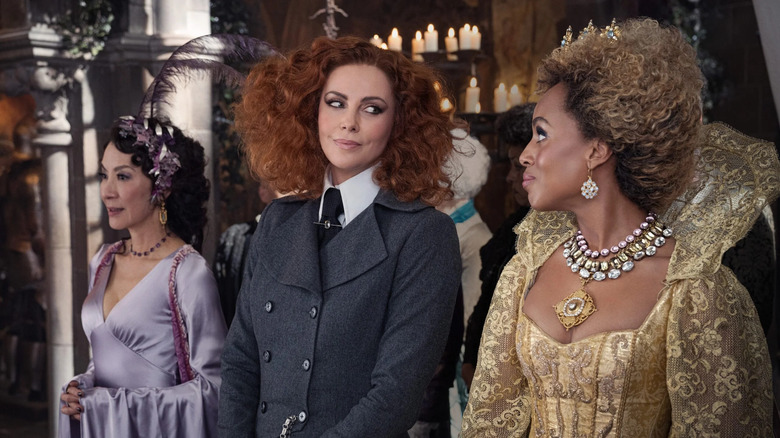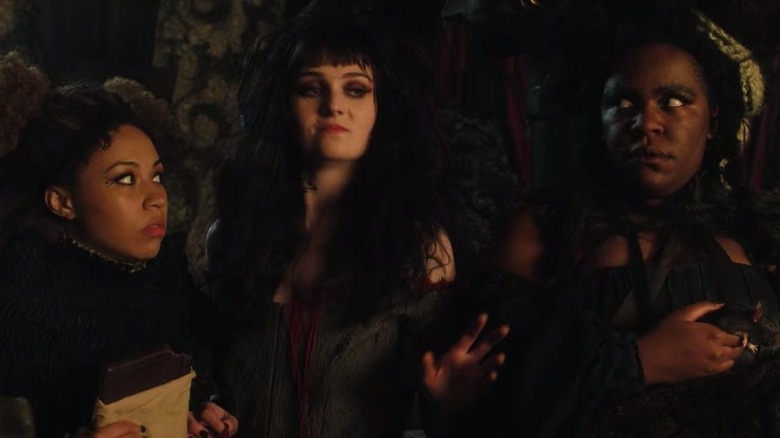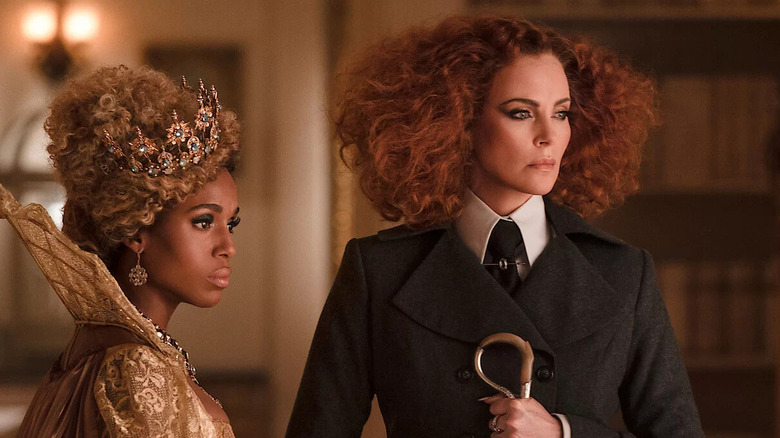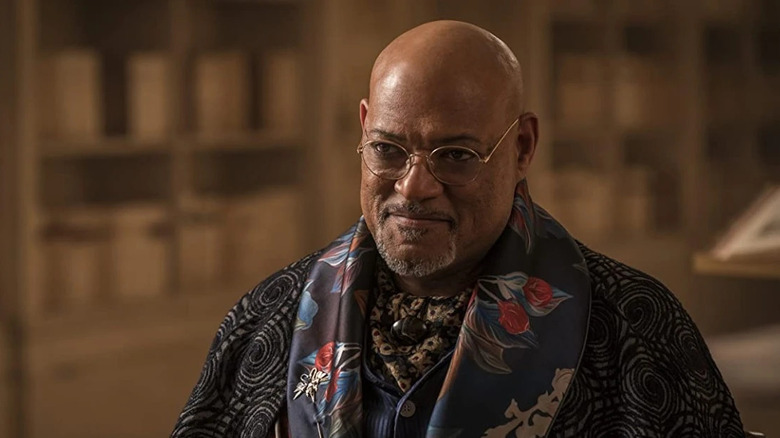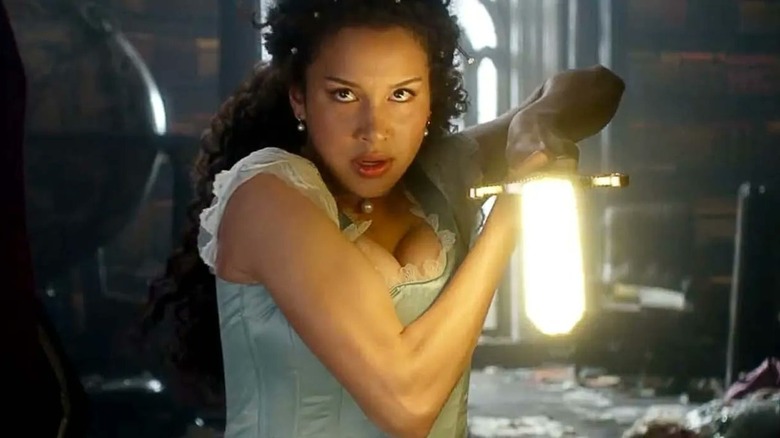Things That Don't Make Sense In The School For Good And Evil
After years of development troubles, the movie adaptation of the best-selling young adult novel "The School for Good and Evil" was finally released on Netflix. Based on the 2013 book by Soman Chainani, the filmed version of this coming-of-age tale of witchcraft was helmed by "Bridesmaids" director Paul Feig and featured a star-studded cast. Unfortunately, all the names working on it couldn't quite make "The School for Good and Evil" a critical hit (via Rotten Tomatoes).
The adventure begins with the friendship of big dreamer Sophie (Sophia Anne Caruso) and pessimistic grim Agatha (Sofia Wylie) in their village of Gavaldon. Soon the two polar opposite besties are swept up into a world of magic and witchcraft, as they are kidnapped and sent to the School for Good and Evil. Here, they are placed in the "wrong" schools with Sophie going to the School for Evil, run by Lady Lesso (Charlize Theron), and Agatha to the School for Good, overseen by Professor Dovey (Kerry Washington). As they try and find their way to where each of them belongs, the duo begins to grow apart and discover the secret truths hidden within both the school and inside themselves.
Over its two-and-a-half runtime, though, there are numerous confusing or glossed-over details in the film. Sure, fantasy and fairytales are all about exploring worlds beyond our reality, but "The School for Good and Evil" breaks our suspension of disbelief a number of times. These are all the things that don't make sense in Netflix's "The School for Good and Evil."
How did Sophie knock a man unconscious and get away with it?
One of the first scenes of the movie is an absurd sequence that is meant to show off Agatha and Sophie's friendship but ends up causing more confusion than anything. The very first thing we learn about the two leads is that they are both outsiders in their village, and all their peers call them witches. While playing with a baby goat in an alleyway, Agatha is approached by a stranger who recognizes her and begins to threaten her for being a witch. It's a contrived scenario in the first place, but when he pulls a knife on her, Sophie appears from behind him to whack the man upside the head with a frying pan, knocking him unconscious.
Obviously, this scene exists to emphasize how much neither Agatha nor Sophie really belongs in Gavaldon and how they look out for each other. On its face, it doesn't really make any sense that Sophie would have the strength to knock him out cold with one blow. Plus, it is quite unbelievable that she could knock out an extremely threatening stranger without any consequences. Sure, he is just a drunk in an alley, but the moment that guy wakes up, he is going to be extremely upset and remember the last person he was talking to was Agatha. And wherever she is, Sophie is not far behind.
How does the bookshop owner know about the schools?
Film and theater fans were jazzed to see stage icon Patti LuPone appear within the first 15 minutes of "The School for Good and Evil." As the bookstore owner in Gavaldon, Mrs. Deauville (LuPone) serves as an exposition dump for Sophie and Agatha, giving them a crash course on the schools. Specifically, she says the schools are where "the true story behind every fairy tale begins," and that the heroes of these stories go to the Good school while the villains attend the Evil school. The big question here is just how does this random woman know all this information about the magical world?
Later in the movie, Lady Lesso makes it seem as if there is little to no knowledge of the magical realm outside of it. She even goes as far as to call the outsiders to her world "Readers," because they only get to read about the fairy tales created at the School for Good and Evil. This implies a binary divide between Readers from the outside and the residents of the magical world, so how has word traveled to the bookseller?
You could argue that Mrs. Deauville hedges her explanations with phrases like "legend has it," but it's fairly suspicious that every bit of information she tells the teen girls is 100% accurate. The sequence is very obviously exposition that serves its purpose, but it still makes little sense how an outsider would know so much about the magic world.
Why do people think Agatha is ugly?
One of the first characterizations we get of Agatha (one that persists throughout the movie) is that along with being dark, moody, and living in a graveyard, she is unruly and unattractive. First, it's the mean boys in Gavaldon making fun of her appearance, and later on, she is bullied by the clique of popular girls at the School for Good. Consistently, Agatha is made out to be ugly, but that characterization makes no sense when you cast a young person as naturally beautiful as Sofia Wylie.
This is meant to contrast Agatha with the other girls at her school, but it ends up coming off as silly and borderline racially insensitive. Many of the comments the characters give regarding Agatha's appearance has to do with her large hair, which is called messy and ugly. And while the character does put her hair up later in the movie, the all-natural hairdo is far from unattractive. Wylie's curly, voluminous hairstyle is common and popular with Black women, so when the white characters in the film call her out for it, we can't help but feel a bit uncomfortable with the loaded connotation that natural Black hair is less professional and not as beautiful as straightened hair (via The Zoe Report).
How old is everyone supposed to be?
The comparisons of this movie to the "Harry Potter" franchise are inevitable, and while the "HP" movie series is just one of many similar works to "The School for Good and Evil", it is undeniably foundational to this subgenre of fantasy. One thing that sets "Harry Potter" apart from "The School for Good and Evil" is how it establishes its setting and rules for the world. The 2022 Netflix movie fails to explain how old any of the students are or if there is any age difference between any of the main characters. In a movie where you are casting 20-somethings as teenagers, this element feels especially confusing.
According to the books' fans, students at the school are supposed to be between 12 and 16 years old, but the movie doesn't make this clear. If anything, it seems the School for Good and Evil in the movie skews older than that. None of the students look younger than high school age, especially not Sophie and Agatha, who are clearly supposed to be in their mid- to late teens and are presumably only in their first year at the school ... since they just started. By leaving out this detail, the School for Good and Evil feels more like a backdrop for the teen drama and less like an actual school, vis-à-vis Hogwarts.
What do the Good boys do all day?
In any magical school story, you know the characters are going to be spending most of their days in class, and this movie is no exception. There are plenty of scenes in "The School for Good and Evil" that show Sophie and Agatha in their respective classrooms, but one group of students is noticeably absent from any of the actual learning taking place.
In "The School for Good and Evil," there are two types of students: the Evers who attend the good school and the Nevers from the evil school. At the School for Good, many of the Evers classes appear to be divided along gender lines, but we never really get to see what the boys do all day.
Of all the boys we see at the "Good" school, the only one that actually is fleshed out as a character is Tedros (Jamie Flatters), so there isn't any perspective into the prospective princes' schedule. In the movie, there are scenes of them practicing archery and swordplay but that's about it. Aside from getting into fights with Never students and brushing up on combat, it doesn't seem like the Ever boys are getting much of an "education" in the same way as the girls — even if their most taxing class is beautification.
Why are there so few faculty members?
Despite its lavish production values, "The School for Good and Evil" often makes itself feel small. Case in point, we see four teachers in the whole movie, and two of them are the heads of the schools in question. Apparently, Lady Lesso and Professor Dovey have enough time to be headmasters and teach a majority of the classes the students attend at their respective schools.
In fact, it is suggested Lesso teaches all the Evil classes, or at least that is what the movie shows. The only other teaching we see happen is in Professor Anemone's (Michelle Yeoh) beautification class and a journey into the forest with the gnome Yuba (Peter Serafinowicz), who is the school woods survival expert — not even a professor. Later, Anemone reveals she used to be head of a whole department but was demoted. The existence of departments makes no sense at all given how barebones the faculty is.
Showing classes and a variety of professors could have fleshed out the world of the movie a bit more, but instead we are left to assume the schools are extremely short-staffed for one vague reason or another. It's unbelievable to think that each school is run with a faculty of two or three people each and a handful of wolf guards.
How do tattoos come to life?
It is difficult to nitpick magic. It is magical, after all. But one moment of magic in "The School for Good and Evil" feels especially silly and nonsensical. Perhaps it's explained better in the books, but the moment where Hester (Freya Theodora Parks), Sophie's rival from day one, unleashes a demon from a tattoo on her neck is a bit too far-fetched for anyone casually tuning in. During a class taught by Lady Lesso, Sophie and Hester butt heads as they do, but Sophie goes a bit too far this time while insulting Hester's mom. This causes the witch girl to rage and summon a fiery, flying skeletal demon from one of her tattoos.
Now, for one, what is a girl of Hester's age doing with so many huge tattoos? We don't of course know the character's ages, but it's safe to assume Hester is well under 18 — the legal age for getting ink done in most countries. Now, that is a modern practice, and we don't even know when "The School for Good and Evil" takes place, so it could be safe to assume those laws don't apply yet. Either way, it doesn't make sense that Hester would be covered in tattoos.
Maybe, quite possibly, the demon tattoo magic is a witch thing. But if that's the case why is Hester the only one we see with ink? Overall, this sequence opens a whole can of worms about how magic works in "The School for Good and Evil," which is never given a proper explanation in the film.
How many years of school are there?
One of the most frustrating parts of "The School for Good and Evil" is how little the movie explains the structure of its titular school. In addition to not knowing the ages of the characters, we also never get any information on the various character's years in school relative to one another. We don't even learn how many years students attend the school. This ultimately doesn't matter to the movie's story, but it does cause quite a bit of confusion early on.
When they first get to the school, Sophie and Agatha are the two students who seem lost. Everyone else seems to be in a clique already, and they all know the procedure for day one. You might think that our duo are the only new students, but that would contradict what the movie says. As it establishes, two Readers from the outside join the incoming class at the schools every year, which implies they accompany a whole new class of students. So where are all the other newbies and how long exactly does one attend the School for Good and Evil? These details are left unanswered by the nearly two-and-a-half-hour movie.
Why does Sophie's sacrifice undo Rafal's plan?
Near the end of "The School for Good and Evil," during Sophie's final encounter with him at the end of the film, the schoolmaster, Rhian (Laurence Fishburne), reveals that he has been his evil brother, Rafal (Kit Young), in disguise. Rafal has been manipulating Sophie the whole time, but in this final manipulation, he convinces her to rule with him as his queen. The two share a kiss, which brings about the end game of Rafal's master plan as the School for Good and Evil begins to crumble. When Agatha bursts in to save her friend, she fights Rafal but finds herself losing and backed up against the wall. With Rafal about to strike the final blow by sending a winged blade into Agatha's chest, Sophie realizes her mistake and jumps in front of her friend, sacrificing herself instead.
Sophie's change of heart makes perfect sense, don't get us wrong, but what happens next is nonsense. After Sophie takes the blow for Agatha, she falls to the ground, and Rafal's magical destruction of the school ceases. So why does Sophie's sacrifice reverse this spell? The movie never bothers to explain. Is it because gaining her love was integral to Rafal's magic and without Sophie, the spell ends? Maybe, but as we learn later this wasn't quite a fatal blow as Sophie still breathes while she is bleeding out. None of the solutions we can speculate quite make sense given the logic the movie presents to the audience.
How did Agatha's kiss save Sophie's life?
The subversive twist at the end of "The School for Good and Evil" is that the "true love's kiss" Sophie was searching for the whole time with Tedros actually happened with Agatha. After Sophie throws herself in front of Agatha, she gets stabbed. After vanquishing Rafal, Agatha runs over to her friend bleeding on the floor and through a face of tears embraces and kisses her — magically healing her injuries. Thematically, this goes to show the power of friendship and that true love doesn't always have to be romantic. But considering that Sophie was only trying to kiss Tedros to switch to the Good school, the fact that this kiss saves her life while she is bleeding out isn't supported by any other magic we see.
This magical moment doesn't ever bother to explain itself, and immediately after this scene, we are thrust straight into an epilogue where Agatha decides to leave Tedros behind and go home with her friend. You can chalk it up to what the power of true love can accomplish, but at the end of the day, the effects of this kiss truly make no sense.
Perhaps some of these concerns will be addressed in a sequel — the film ends on a cliffhanger, and the "School for Good and Evil" author is hopeful Netflix will greenlight more sequels. Director and co-writer Paul Feig has plans for more films (via ScreenRant), so time will tell whether the many questions raised in the Netflix film will be addressed at all in the future.
